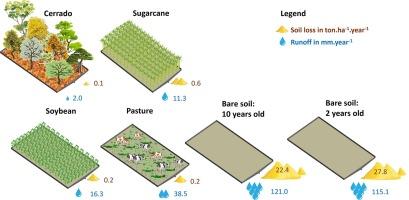Land use transformations in the Brazilian Savanna: A decade of soil erosion and runoff measurements
IF 5.4
1区 农林科学
Q1 GEOSCIENCES, MULTIDISCIPLINARY
引用次数: 0
Abstract
Changes in land cover and land use (LULC) are one of the main drivers of erosion and runoff. How ever, most research has relied on short-term observations and only focused on one or two land cover types. We investigated the long-term trade-off between common agricultural land covers (sugarcane, pasture, and soybean), runoff, and soil loss rates. We compared these to native forest (wooded Cerrado) and bare soil. The field observations were done in 100 m2 experimental plots in Brazil maintained during the past 10 years. The paper provides three main contributions: (1) long-term runoff and soil loss rates of plots under different LULCs, (2) comparison of runoff, soil loss, and pedological characteristics between plots constructed 10 years apart, and (3) analysis of the trade-off between different LULCs. When ranking land covers based on runoff and soil loss rates, there is a shift in ranking positions, making it difficult to determine which one is more environmentally harmful. However, it is evident that whatever agricultural practice is used, there is a significant impact when compared to native forest. For example, the area converted to pasture resulted in almost 20 times higher runoff, while conversion to sugarcane resulted in 5 times higher soil loss. Not only land cover plays a major influencing factor, but also weathering exposing time. Areas under the same land cover and environmental conditions had different rates of soil loss and runoff due to long-term exposure effects such as soil crusting. Our findings have high relevance for the hydrological and agricultural community by demonstrating (i) the magnitude of trade-off in terms of soil loss and runoff due to land cover changes and (ii) that soil loss should not be assumed to be a linear process over time, as it is commonly assumed.

巴西热带稀树草原的土地利用变化:十年土壤侵蚀和径流测量结果
土地覆被和土地利用(LULC)的变化是造成侵蚀和径流的主要原因之一。然而,大多数研究都依赖于短期观测,而且只关注一种或两种土地覆被类型。我们研究了常见农田植被(甘蔗、牧草和大豆)、径流和土壤流失率之间的长期权衡。我们将其与原始森林(Cerrado 林区)和裸土进行了比较。实地观测是在巴西 100 平方米的实验地块中进行的,该实验地块在过去 10 年中一直保持不变。本文有三大贡献:(1)不同 LULCs 下地块的长期径流和土壤流失率;(2)相隔 10 年建造的地块之间的径流、土壤流失和土壤学特征比较;(3)不同 LULCs 之间的权衡分析。根据径流和土壤流失率对土地覆被进行排序时,排序位置会发生变化,因此很难确定哪种土地覆被对环境的危害更大。然而,显而易见的是,无论采用哪种农业耕作方式,与原始森林相比都会产生重大影响。例如,改种牧草的面积导致径流增加近 20 倍,而改种甘蔗则导致土壤流失增加 5 倍。不仅土地覆盖是一个主要影响因素,风化暴露时间也是一个重要因素。在相同的土地覆盖和环境条件下,由于长期暴露效应(如土壤板结),土壤流失和径流速率不同。我们的研究结果对水文和农业界具有重要意义,因为它证明了:(i) 土地覆被变化对土壤流失和径流的影响程度;(ii) 土壤流失不应像人们通常认为的那样是一个随时间变化的线性过程。
本文章由计算机程序翻译,如有差异,请以英文原文为准。
求助全文
约1分钟内获得全文
求助全文
来源期刊

Catena
环境科学-地球科学综合
CiteScore
10.50
自引率
9.70%
发文量
816
审稿时长
54 days
期刊介绍:
Catena publishes papers describing original field and laboratory investigations and reviews on geoecology and landscape evolution with emphasis on interdisciplinary aspects of soil science, hydrology and geomorphology. It aims to disseminate new knowledge and foster better understanding of the physical environment, of evolutionary sequences that have resulted in past and current landscapes, and of the natural processes that are likely to determine the fate of our terrestrial environment.
Papers within any one of the above topics are welcome provided they are of sufficiently wide interest and relevance.
 求助内容:
求助内容: 应助结果提醒方式:
应助结果提醒方式:


